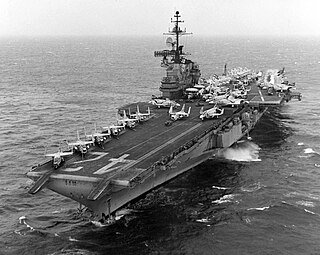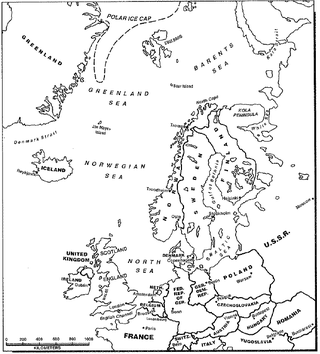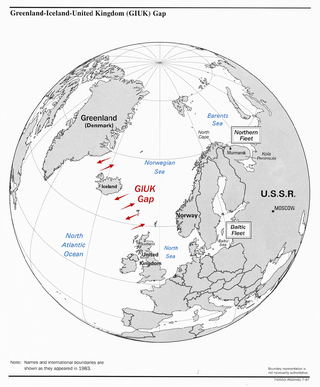Operation history
The objective of the Allied ("Blue") forces was to dislodge enemy ("Green") invasion forces from their occupying positions in the Eastern Mediterranean. Green forces consisted of the Italian 56th Tactical Air Force and submarines of the United States, Great Britain, France, Greece, and Turkey lying in wait to ambush the Blue amphibious convoy departing from Italian embarkation ports. Over 170 warships and 700 aircraft were involved in Operation Longstep. [4]
Blue naval forces were centered around the U.S. Sixth Fleet, under the command of Vice Admiral John H. Cassady, USN, and its two aircraft carriers, the Franklin D. Roosevelt and Wasp. Air sorties were flown by American and Italian aircraft attacking Blue naval forces, and Blue carrier-based aircraft counter-attacking Green military targets in northern Italy. [4] Operation Longstep concluded with an amphibious landing at Lebidos Bay south of İzmir, Turkey, involving 3000 French, Italian, and Greek troops, including the Third Battalion, Second Marines, under the overall command of General Robert E. Hogaboom, USMC. [4] [7]
In the actual landing at Lebidos Bay, the Italians went ashore at H-Hour minus six in a diversionary attack on nearby Doganbey Island. This was followed by the main landing force led U.S. Marines along with the French and Greek troops. After securing the beach-head and setting up a defensive perimeter, the landing force was re-embarked onto the amphibious shipping off-shore, concluding Exercise Longstep. [4]
Carrier aviation units
Carrier Air Group Seventeen (CVG-17) embarked on USS Franklin D. Roosevelt (CVB-42): [8]
|
|---|
| - Fleet Composite Squadron 62 (VC-62) Detachment: McDonnell F2H-2P Banshee
- Fleet Composite Squadron 33 (VC-33) Detachment: Douglas AD-4N Skyraider
- Fleet Composite Squadron 12 (VC-12) Detachment: Douglas AD-4W Skyraider
- Utility Helicopter Squadron 2 (HU-2) Detachment: Piasecki HUP-1
|
Carrier Air Group Eighteen (CVG-18) embarked on USS Wasp (CV-18): [9]
|
|---|
| - Fleet Composite Squadron 62 (VC-62) Detachment 38: McDonnell F2H-2P Banshee
- Fleet Composite Squadron 12 (VC-12) Detachment 38: Douglas AD-4W Skyraider
- Utility Helicopter Squadron 2 (HU-2) Detachment: Piasecki HUP-1
|

The Sixth Fleet is a numbered fleet of the United States Navy operating as part of United States Naval Forces Europe-Africa. The Sixth Fleet is headquartered at Naval Support Activity Naples, Italy. The officially stated mission of the Sixth Fleet in 2011 is that it "conducts the full range of Maritime Operations and Theater Security Cooperation missions, in concert with coalition, joint, interagency, and other parties, in order to advance security and stability in Europe and Africa." The current commander of the Sixth Fleet is Vice Admiral Thomas E. Ishee.

The Supreme Headquarters Allied Powers Europe (SHAPE) is the military headquarters of the North Atlantic Treaty Organization's (NATO) Allied Command Operations (ACO) that commands all NATO operations worldwide. SHAPE is situated in the village of Casteau, near Mons, Belgium.

USS Wasp (CV/CVA/CVS-18) was one of 24 Essex-class aircraft carriers built during World War II for the United States Navy. The ship, the ninth US Navy ship to bear the name, was originally named Oriskany, but was renamed while under construction in honor of the previous Wasp (CV-7), which was sunk 15 September 1942. Wasp was commissioned in November 1943, and served in several campaigns in the Pacific Theater of Operations, earning eight battle stars. Like many of her sister ships, she was decommissioned shortly after the end of the war, but was modernized and recommissioned in the early 1950s as an attack carrier (CVA), and then eventually became an antisubmarine carrier (CVS). In her second career, she operated mainly in the Atlantic, Mediterranean, and Caribbean. She played a prominent role in the manned space program, serving as the recovery ship for five Project Gemini missions: Gemini IV, Gemini VI, Gemini VII, Gemini IX, and Gemini XII. She was retired in 1972, and sold for scrap in 1973.

USS Franklin D. Roosevelt (CVB/CVA/CV-42) was the second of three Midway-class aircraft carriers. To her crew, she was known as "Swanky Franky," "Foo-De-Roo," or "Rosie," with the last nickname probably the most popular. Roosevelt spent most of her active deployed career operating in the Mediterranean Sea as part of the United States Sixth Fleet. The ship was decommissioned in 1977 and was scrapped shortly afterward. She was the first aircraft carrier of the United States Navy to be named in honor of a president of the United States.

The United States Second Fleet is a numbered fleet in the United States Navy responsible for operations in the East Coast and North Atlantic Ocean. Established after World War II, Second Fleet was deactivated in 2011, when the United States government believed that Russia's military threat had diminished, and reestablished in 2018 amid renewed tensions between NATO and Russia.

The Joint Force CommandNaples is a NATO military command based in Lago Patria, in the Metropolitan City of Naples, Italy. It was activated on 15 March 2004, after effectively redesigning its predecessor command, Allied Forces Southern Europe (AFSOUTH), originally formed in 1951. In NATO Military Command Structure terms, AFSOUTH was a "Major Subordinate Command". The commander of JFC Naples reports to the Supreme Allied Commander Europe at the Supreme Headquarters Allied Powers Europe, Casteau, Belgium.
The Fleet Problems are a series of naval exercises of the United States Navy conducted in the interwar period, and later resurrected by Pacific Fleet around 2014.

The Supreme Allied Commander Atlantic (SACLANT) was one of two supreme commanders of the North Atlantic Treaty Organisation (NATO), the other being the Supreme Allied Commander Europe (SACEUR). The SACLANT led Allied Command Atlantic was based at Norfolk, Virginia. The entire command was routinely referred to as 'SACLANT'.

Carrier Air Wing Eight (CVW-8), is a United States Navy aircraft carrier air wing based at Naval Air Station Oceana, Virginia. The air wing is attached to the aircraft carrier USS Gerald R. Ford (CVN-78)

Exercise Mainbrace was the first large-scale naval exercise undertaken by the newly established Allied Command Atlantic (ACLANT), one of the two principal military commands of the North Atlantic Treaty Organization (NATO). It was part of a series of NATO exercises jointly commanded by Supreme Allied Commander Atlantic Admiral Lynde D. McCormick, USN, and Supreme Allied Commander Europe General Matthew B. Ridgeway, U.S. Army, during the fall of 1952.

Exercise Strikeback aka Operation Strikeback was a major naval exercise of the North Atlantic Treaty Organization (NATO) that took place over a ten-day period in September 1957.

Carrier Air Wing Six (CVW-6) was a United States Navy aircraft carrier air wing whose operational history spans from the middle of World War II to the end of the Cold War. Established in 1943 as Carrier Air Group Seventeen (CVG-17), it would be re-designated several times during its establishment, including Carrier Air Group Six (CVG-6) as the second unit to be so designated. The first Carrier Air Group Six served for just over two years during World War II, but drew on the history of the Enterprise Air Group established in 1938 and active in the early battles of the Pacific War, being disestablished after the first year of the conflict. During its time in USS Enterprise (CV-6), it was the Navy's only carrier-based air group to carry out three complete tours of duty during World War II.

Exercise Grand Slam was an early major naval exercise of the newly formed North Atlantic Treaty Organization (NATO). This 1952 combined naval exercise took place in the Mediterranean Sea, and it included a naval force that was described as being "the largest armada to be assembled in that area since the end of World War II." Exercise Grand Slam was an early test for NATO's Allied Forces Southern Europe. With Exercise Longstep, this exercise served as the prototype for future NATO maritime exercises in the Mediterranean Sea during the Cold War.

Commander, Carrier Strike Group FOUR is the U.S. Fleet Forces Command formation charged with training and certifying Atlantic Fleet Carrier Strike Groups, Amphibious Ready Groups, and independently deploying surface ships. Its mission is to "Conduct safe and effective Strike Force Training of the Atlantic Fleet."

Operation Deep Water was a 1957 NATO naval exercise held in the Mediterranean Sea that simulated protecting the Dardanelles from a Soviet invasion. By controlling this bottleneck in a war situation, the Soviet Black Sea Fleet would be prevented from entering the Mediterranean.

Summer Pulse 2004 (SP04) was the codename for a worldwide surge deployment that served as the first full-scale test of the United States Navy's then-new Fleet Response Plan (FRP). During Summer Pulse 2004, a total of seven carrier strike groups were underway at the same time in five different Numbered fleet areas of responsibility. This number of underway carrier strike groups had not been matched since the six carrier battle groups deployed during Operation Desert Storm. In addition to the carriers, the Navy also deployed 17 submarines and one submarine tender.
Carrier Strike Group 6 was a United States Navy carrier strike group. Its last homeport was Naval Station Mayport at the mouth of the St. Johns River near Jacksonville, Florida. Fifty-one Rear Admirals served as Commander, Carrier Division/Group/Strike Group 6 from August 1944 until the command was deactivated in April 2007.

Naval Striking and Support Forces NATO (STRIKFORNATO) is a naval command of Allied Command Operations of North Atlantic Treaty Organization (NATO). It is part of the NATO Force Structure. STRIKFORNATO is commanded by the Commander of the United States Sixth Fleet, and it is the only command capable of leading an expanded maritime task force. Its predecessor was Naval Striking and Support Forces Southern Europe (STRIKFORSOUTH); the name change took place in 2004.
















